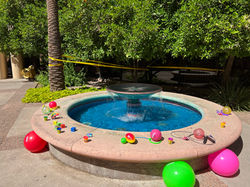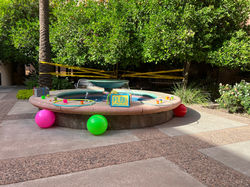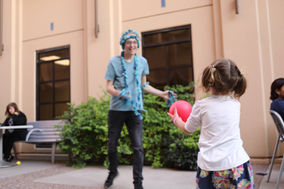top of page
Monster recess
Background
I initially entered this process with the goal of creating "fun," interactive, and engaging facilitated workshops related to shame resilience and hegemonic masculinity. Shame, while an important topic to my research and a necessary thing to consider when grappling with the human experience, often does not constitute a "fun" or enjoyable topic of discussion, and I became interested in exploring ways to make the process of shame resilience (based in the work of Brené Brown, bell hooks, and others) more fun and "irressistible" rather than a chore. Ideally, this would increase people's desire to engage in the process and increase joy.

Ideation
As I moved further along in this process, I pivoted more toward an interactive performance experience (instead of a facilitation) and toward something grounded more in broader experiences of shame than in the specific hegemonic masculinity context mentioned earlier. I found that the heavy theory bogged me down from creating something "delicious," fun, and true to people's experiences, so I pivoted to considering how play, shame, childhood, and vulnerability might interact in a space built around the metaphor of recess. Below is the slideshow for my initial pitch and some drawings I created as I continued to refine my ideas.


Playtests & Rehearsals
From this initial pitch, I began to test some ideas and continue to design how this recess space would look. Along the way, I added the "Shame Monster" as a performer, and then later I added two "Play Monsters," all three of whom interacted in the recess world that audience members could join. Additionally, I added a "Book of Monster" challenge that gave players the opportunity to interact with the Shame Monster directly to try to rid the play space of shame.
I have a list of my learnings over the course of these rehearsals and playtests at the end of this page in the "Findings" section, and I encourage you to check them out. In the meantime, here is the TLDR version of my rehearsal learnings:
1. Adults are drawn to play and enjoy a free space to organically play when directly invited.
2. Objects alone cannot create engagement.
3. Monster characters added appropriate fun and distance to explore the topics.
Enjoy photos and videos from rehearsal in the galleries below!
 |
|---|
 |
 |
 |
 |
 |




1/7
Flip through this gallery to see how the play space grew over the course of the playtests!




1/12
Final performance
In the end, I emerged with an interactive performance piece where the Play Monsters invited people to play freely with the toys and objects in the "recess" space. In the midst of this play, the Shame Monster would (in a silly way) interrupt the play by shaming one of the Play Monsters or telling people that they had to play the "shame way." After a certain number of disruptions, one of the Play Monsters would get upset and if a participant comforted them, the Play Monster would tell them about the Book of Monster that tells about the "Legend of the Shame Monster" and what the participants needed to do to make the Shame Monster stop being so mean (and to get the Shame Monster to play with everyone again). Participants had the option to engage at various levels, including as a "wader" who simply played or observed play in the space, as a "swimmer" who engaged in play and interacted with the Shame Monster, and as a "diver" who sought the Book of Monster and had conversations with the Shame Monster.
The final performance of Monster Recess occurred during a broader "Mash Up" event with other interactive performances, musicians, and events from the School of Music, Dance, and Theatre. Several students, faculty members, and families attended the event. Above is a video from the event.




1/11
Below is the "Actor Outline" that I gave to the other two performers in the piece to clarify the event in an accessible way. I have also included the final draft of the more detailed script for "Monster Recess" that includes some changes after this final performance. This is the baseline script I would use for the next iteration.
Findings
Throughout the process, I recorded my learnings, observations, questions, and feedback as "findings" in an informal journal. If you want more of an insight into my process, check out my three "Findings" documents and my end-of-semester reflection. "Classroom Findings" focused on learnings or insights from in-class activities (game design, world building, pitching, etc.). "Playtest Findings" include my notes from rehearsals and playtests where I furthered design on my project. "External Findings" include observations from other performances I watched this semester or everyday interactions I had with people or objects "in the real world." Below is a presentation of the summary of my findings.




bottom of page











